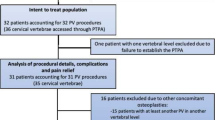Abstract
The objective of the present study was to determine the frequency of gas retention in the renal vein following carbon dioxide intraosseous venography in the prone position and, while citing references, to examine its onset mechanisms. All percutaneous vertebroplasties performed at our hospital from January to December 2005 were registered and retrospectively analyzed. Of 43 registered procedures treating 79 vertebrae, 28 procedures treating 54 vertebrae were analyzed. Vertebral intraosseous venography was performed using carbon dioxide as a contrast agent in all percutaneous vertebroplasty procedures. In preoperative and postoperative vertebral CT, gas retention in the renal vein and other areas was assessed. Preoperative CT did not show gas retention (0/28 procedures; 0%). Postoperative CT confirmed gas retention in the renal vein in 10 of the 28 procedures (35.7%). Gas retention was seen in the right renal vein in 8 procedures (28.6%), in the left renal vein in 5 procedures (17.9%), in the left and right renal veins in 3 procedures (10.7%), in vertebrae in 22 procedures (78.6%), in the soft tissue around vertebrae in 14 procedures (50.0%), in the spinal canal in 12 procedures (42.9%), and in the subcutaneous tissue in 5 procedures (17.9%). In conclusion, in our study, carbon dioxide gas injected into the vertebra frequently reached and remained in the renal vein.

Similar content being viewed by others
References
Tanigawa N, Komemushi A, Kariya S et al (2005) Intraosseous venography with carbon dioxide contrast agent in percutaneous vertebroplasty. AJR 184:567–570
Jansen ME, Evans AJ, Mathis JM et al (1997) Percutaneous polymethylmethacrylate vertebroplasty in the treatment of osteoporotic vertebral body compression fractures: technical aspect. Am J Neuroradiol 18:1897–1904
McGraw JK, Heatwole EV, Strnad BT et al (2002) Predictive value of intraosseous venography before percutaneous vertebroplasty. J Vasc Interv Radiol 13:149–153
Gaughen JR Jr, Jensen ME, Schweickert PA et al (2002) Relevance of antecedent venography in percutaneous vertebroplasty for the treatment of osteoporotic compression fractures. Am J Neuroradiol 23:594–600
Vasconcelos C, Gailloud P, Beauchamp NJ et al (2002) Is percutaneous vertebroplasty without pretreatment venography safe? Evaluation of 205 consecutives procedures. Am J Neuroradiol 23:913–917
Peh WC, Gilula LA (2003) Additional value of a modified method of intraosseous venography during percutaneous vertebroplasty. AJR 180:87–91
Leibold RA, Gilula LA (2002) Sterilization of barium for vertebroplasty: an effective, reliable, and inexpensive method to sterilize powders for surgical procedures. AJR 179:198–200
Groen RJ, du Toit DF, Phillips FM et al (2004) Anatomical and pathological considerations in percutaneous vertebroplasty and kyphoplasty: a reappraisal of the vertebral venous system. Spine 29:1465–1471
Baston OV (1940) The function of the vertebral veins and their role in the spread of metastases. Arch Surg 112:138–149
Hawkins IF, Caridi JG (1998) Carbon dioxide (CO2) digital subtraction angiography: 26-year experience at the University of Florida. Eur Radiol 8:391–402
Chung SE, Lee SH, Kim TH et al (2006) Renal cement embolism during percutaneous vertebroplasty. Eur Spine J Suppl 5:590–594
Author information
Authors and Affiliations
Corresponding author
Rights and permissions
About this article
Cite this article
Komemushi, A., Tanigawa, N., Kariya, S. et al. Intraosseous Venography with Carbon Dioxide in Percutaneous Vertebroplasty: Carbon Dioxide Retention in Renal Veins. Cardiovasc Intervent Radiol 31, 1174–1177 (2008). https://doi.org/10.1007/s00270-008-9325-5
Received:
Revised:
Accepted:
Published:
Issue Date:
DOI: https://doi.org/10.1007/s00270-008-9325-5




